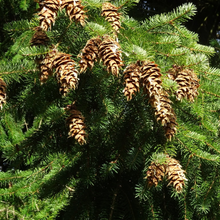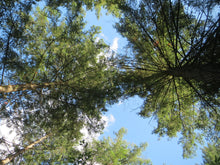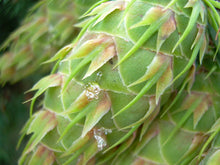Pseudotsuga menziesii
Douglas fir is Oregon’s state tree, the most common evergreen in the Pacific Northwest, and arguably the most commercially important tree in the country. This majestic over-story conifer has an upright, pyramidal form with a strong central leader that can tower up to 300 feet, but generally tops out around 100-125 feet in home gardens. It is impressively fast-growing, making it a pioneer species that can transform a disturbed area (post clearcut, wildfire or windfall) into a young forest in under 50 years. Doug fir cones are iconic and have many children’s stories about them. Pacific Northwest kids of all ages can easily identify them by the bracts of its seeds, poking out beyond each scale, that resemble the tail and hind legs of countless mice hiding, half-tucked into the cones.
Please note: when growing in a container, Doug fir is often spindly and not very attractive, but once it is planted in the ground, out in the open, it will quickly develop into the normal, robust, Christmas tree shape.
- Plant type/canopy layer: evergreen, perennial, large tree
- Size at maturity: up to 300” tall, usually 100’-125’ in garden settings, 30 - 50' wide (canopy)
- Light requirements: full sun, part sun/part shade
- Moisture requirements: dry to seasonally wet soil
- Bloom time: n/a
- Growth rate/ease: fast growing, very easy to grow
- Wildlife support: seeds (found inside the cones) are adored by countless birds and small mammals including Douglas Squirrels, sparrows, Pine Siskins, juncos, crossbills and purple finch; foliage and twigs are an important food source for deer and elk, especially in winter (though they usually browse lightly and only on low branched, not affecting the overall health of the plant, so this species is still generally considered “deer resistant”); needles and male cones are important winter food for Douglas Squirrels, other small mammals and some birds, such as Blue Grouse; inner bark is an important food source for porcupines; foliage is the primary nesting material for Red Voles, which are listed as a sensitive species in Oregon; overall tree is a caterpillar host plant and larval food source for around 80 species of native butterflies and moths including the Pine White butterfly and the Ceanothus Silkmoth; snags provide cavity-nesting habitat for numerous forest birds
- Native habitat/range: common in forest habitats from sea level to subalpine mountain sites from Western Canada down the Pacific coast to central California, and from the Canadian Rockies south to isolated communities in Mexico. In Oregon and Washington its range is continuous from the Cascades crest west to the Pacific Ocean. Portland Plant List - yes.
- Special features & uses: evergreen; wildlife favorite; medicinal; fire resistant; deer resistant; landscape uses include bank stabilization/erosion control, as a windbreak (when planted in groups), butterfly gardens, and woodland gardens; most important timber tree in the United States used for pulp, pilings, dimensional lumber, plywood, flooring, many other building materials, paper products and christmas trees; indigenous people traditionally used it for firewood and tools such as spear and harpoon shafts
Gardening with Douglas Fir: Towering Doug firs are a wonderful asset for a habitat garden that resembles the lush northwest forest. It can thrive in almost any area that gets some sunshine. It can handle almost any amount of soil moisture and is drought tolerant - but its preference is well-drained, moist to slightly drier soils with medium drainage and lots of decomposed organic matter. Sometimes people struggle to find the right plants for their spacious Doug fir understory - until they discover the joy of gardening with natives! Doug fir provides an ideal canvas for native understory trees and shrubs like vine maple (Acer circinatum), salal (Gaultheria shallon), pacific rhododendron (Rhododendron macrophyllum), Oregon-grape (Mahonia aquifolium), red huckleberry (Vaccinium parvifolium), salmonberry (Rubus spectabilis), oceanspray (Holodiscus discolor), snowberry (Symphoricarpos albus) and so many groundcovers. If you must prune, do so in winter when wood boring insects are less active. As with most conifers, it is important never to “top” these trees.
Photo Credit 1: "Cônes du Sapin de Douglas, Pseudotsuga menziesii, Pinacées, Arboretum de Chèvreloup" by olive.titus is licensed under CC PDM 1.0
Photo Credit 2: "Pseudotsuga menziesii" by anro0002 is licensed under CC BY-SA 2.0
Photo Credit 3: "Green Douglas-fir (Pseudotsuga menziesii) cones with resin" by benet2006 is licensed under CC BY 2.0






